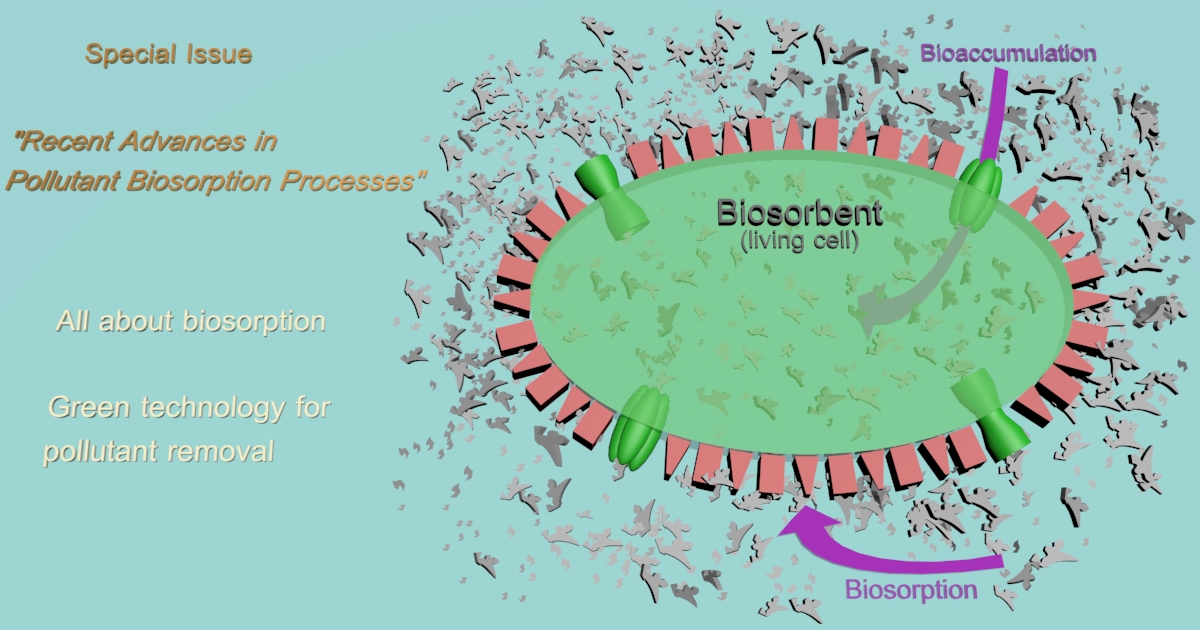Recent Advances in Pollutant Biosorption Processes
A special issue of Processes (ISSN 2227-9717). This special issue belongs to the section "Environmental and Green Processes".
Deadline for manuscript submissions: closed (30 May 2023) | Viewed by 15166

Special Issue Editor
Interests: biosorption; bioremediation; microalgae; toxicity
Special Issues, Collections and Topics in MDPI journals
Special Issue Information
Dear Colleagues,
The pollution of natural environments is a problem that concerns society as a whole, and for this reason, the development of technologies that make it possible to eliminate pollutants from natural environments is an essential practice. At present, biosorption is an effective technology for the removal of pollutants, and it is considered to be environmentally friendly. For this reason, it is one of the main tools used in environmental technologies. The development of this technology is booming, and numerous papers have been published on biosorption and its related processes. In recent years, a large number of materials have been evaluated for their possible applications as biosorbents, from dead biomass to living biomass, both free and immobilized; even different patents have been developed. However, there is still much research to be conducted in this field to develop new, cheap, and efficient materials that can improve the potential of this technology. For this reason, it is both interesting and necessary to dedicate a Special Issue to these processes, in which recent information on this technology can be compiled, and the latest research advances developed can be presented. In this Special Issue on "Recent Advances in Pollutant Biosorption Processes", researchers on this topic can publish their contributions. Topics for this Special Issue include, but are not limited to, the following:
- General laboratory studies on biosorption. Revisions are also welcome;
- The development of new materials (composite materials) for use in biosorption;
- Application of biosorption in bioremediation methodologies.
Prof. Dr. Jose Enrique Torres Vaamonde
Guest Editor
Manuscript Submission Information
Manuscripts should be submitted online at www.mdpi.com by registering and logging in to this website. Once you are registered, click here to go to the submission form. Manuscripts can be submitted until the deadline. All submissions that pass pre-check are peer-reviewed. Accepted papers will be published continuously in the journal (as soon as accepted) and will be listed together on the special issue website. Research articles, review articles as well as short communications are invited. For planned papers, a title and short abstract (about 100 words) can be sent to the Editorial Office for announcement on this website.
Submitted manuscripts should not have been published previously, nor be under consideration for publication elsewhere (except conference proceedings papers). All manuscripts are thoroughly refereed through a single-blind peer-review process. A guide for authors and other relevant information for submission of manuscripts is available on the Instructions for Authors page. Processes is an international peer-reviewed open access monthly journal published by MDPI.
Please visit the Instructions for Authors page before submitting a manuscript. The Article Processing Charge (APC) for publication in this open access journal is 2400 CHF (Swiss Francs). Submitted papers should be well formatted and use good English. Authors may use MDPI's English editing service prior to publication or during author revisions.
Keywords
- biosorption
- bioaccumulation
- bioremediation
- living biomass
- immobilized biomass
- composite materials
Benefits of Publishing in a Special Issue
- Ease of navigation: Grouping papers by topic helps scholars navigate broad scope journals more efficiently.
- Greater discoverability: Special Issues support the reach and impact of scientific research. Articles in Special Issues are more discoverable and cited more frequently.
- Expansion of research network: Special Issues facilitate connections among authors, fostering scientific collaborations.
- External promotion: Articles in Special Issues are often promoted through the journal's social media, increasing their visibility.
- Reprint: MDPI Books provides the opportunity to republish successful Special Issues in book format, both online and in print.
Further information on MDPI's Special Issue policies can be found here.





